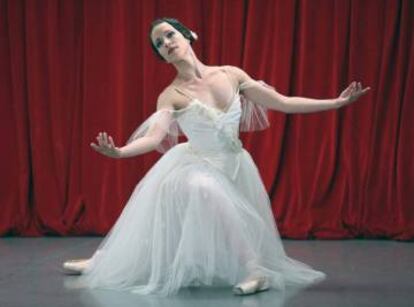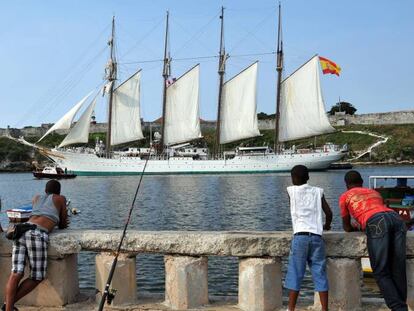Triumphant presentation in Miami by Cuban dissident ballerinas
Company founder Pedro Pablo Peña has become an icon in Florida and throughout North America thanks to his policy of welcoming defecting dancers

Miami Dade County Auditorium was packed on Saturday night while outside subtropical storms battered the city. Wind, thunder, lightning, and a lot of water. It seemed like the world could end in the space of just 10 minutes. But then the sun came out. The function was a unique experience, as is the custom when the Cuban Classical Ballet of Miami delivers its end-of-spring performance. The company is part of the Miami Hispanic Arts Center and both work under the artistic direction of Pedro Pablo Peña, its founder and the man who has become an icon in Florida and throughout North America thanks to his policy of welcoming defecting Cuban dancers – no matter how they get to him.
Just a few weeks ago, three talented and very young soloists left their Canadian tour and entered the US
The international press had been reporting that Amaya Rodríguez, the lead ballerina from the Cuban National Ballet, had defected. She crossed the Mexican border and entered the United States. Just a few weeks ago, three talented and very young soloists left their Canadian tour and entered the United States. The Cuban Adjustment Act allows any Cuban citizen who lands on American soil to apply for legal residence. In 2014, eight Cuban artists defected while on tour in Puerto Rico and 84 more have fled to the United States since 2015. “This cannot be overlooked,” Peña told this newspaper, “even if they talk about embassies, trips required by protocol and economic improvements in high politics. None of that has reached ordinary people. Dancers, like the Cuban people, lack freedom, livelihoods and possibilities to grow.”
The gala reached its climax when Amaya Rodríguez and Arionel Vargas took the stage to dance the second act in “Giselle.” Vargas was the lead dancer at the English National Ballet. He has replaced Carlos Guerra, the principal at Miami City Ballet, another dancer who crossed the US-Mexican border. Guerra suffered a severe shoulder injury during dress rehearsal just 12 hours before the show.
Vargas, who had never worked with Rodríguez before and who also had his own parts to dance, took on the challenge. The public gave the pair a standing ovation.
Hilarion was played by another Cuban native who defected in 2014. Jorge Oscar Sánchez now enjoys a brilliant career at the Washington Ballet. His has become a name to remember.
Sign up to our newsletter
EL PAÍS English Edition has launched a weekly newsletter. Sign up today to receive a selection of our best stories in your inbox every Saturday morning. For full details about how to subscribe, click here.
Two of the artists who crossed the Canadian border a few weeks ago, Masiel Alonso and Mayrel Martínez, danced Pas de Trois in “Swan Lake” with Ignacio Galíndez, another dancer who defected in 2014. Galíndez is a young man who has a lot say, a perfect dancer’s figure, a natural grace that announces itself before he takes the stage and that is his great strength, along with the virtuoso skill that young Cuban dancers are known for.
Marizel Fumero was delicate and yet confident in her technique as she danced Pas de Deux in “Romeo and Juliet” with Vargas. Then she took on the role of Queen of Willis in “Giselle” where she danced with authority, firm footing and presence. Fumero was invited to dance in London in 2012 but she fled to the Milwaukee Ballet where she would be safe from deportation.
Peña created a demanding program that highlighted the role of Russian masters such as Azari Plisetski in Cuban ballet as well as the teachings of the Puerto Rican choreographer José Parés and, especially, the great maestro Fernando Alonso. “The young people must know, they must be told where they came from, what they have been taught and why they are able to draw applause and enthusiasm everywhere. It is not a supernatural miracle. It is the union of talent and work, in this case, of daring and determination to start over while you can.” Some of the members of the Cuban Classical Ballet of Miami will attend the Ravello Festival in Italy on August 20 to deliver an unprecedented performance that will bring Cuban dancers from the island and abroad together for the first since the United States and Cuba renewed diplomatic relations in December 2014.
English version by Dyane Jean François.
Tu suscripción se está usando en otro dispositivo
¿Quieres añadir otro usuario a tu suscripción?
Si continúas leyendo en este dispositivo, no se podrá leer en el otro.
FlechaTu suscripción se está usando en otro dispositivo y solo puedes acceder a EL PAÍS desde un dispositivo a la vez.
Si quieres compartir tu cuenta, cambia tu suscripción a la modalidad Premium, así podrás añadir otro usuario. Cada uno accederá con su propia cuenta de email, lo que os permitirá personalizar vuestra experiencia en EL PAÍS.
¿Tienes una suscripción de empresa? Accede aquí para contratar más cuentas.
En el caso de no saber quién está usando tu cuenta, te recomendamos cambiar tu contraseña aquí.
Si decides continuar compartiendo tu cuenta, este mensaje se mostrará en tu dispositivo y en el de la otra persona que está usando tu cuenta de forma indefinida, afectando a tu experiencia de lectura. Puedes consultar aquí los términos y condiciones de la suscripción digital.










































